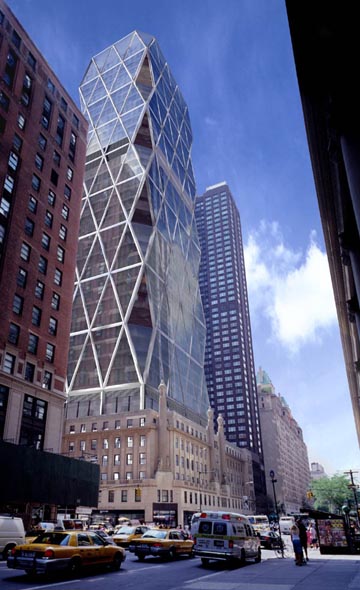The City didn’t have to be the way it was, as Delirious New York explains. There were plenty of alternate proposals for the perfect urban landscape, but once the grid was in place, there wasn’t much one could do. Le Corbusier (who, remarkably, is recognized by my Word spellchecker), envisioned the modernist urban design as broad parks dotted with enormous towers. A perfect example of this can be seen from the north looking down on the Corbu-influenced UN building. Seen as you drive down the FDR drive, it is the perfect example of this sort of modernism, and one is taken by the difference between this perspective and the more quotidian views from street level facing east, where while the building is certainly somewhat set off, it is, more or less, just another building. It may have the tower and the park, but it doesn’t have the majesty that’s apparent from the northeast perspective. The grid makes it more mundane than it really is, even though it is not a part of the grid itself.
Because of the sheer number of people in the City, space, both horizontal and vertical, is at a premium. There simply aren’t very many expanses that aren’t filled up, with the wonderful sanity-preserving exception of Central Park. Most of the buildings, designed as they are for commerce, don’t give up a lot of their space to pointless aesthetics: the space is for offices, or shops, not breathing room. There are places to go in NYC, however, where there are enormous open indoor spaces—the cathedrals. NYC is chock-filled with rather impressive religious spaces very much in the tradition of the classic Christian spiritual building. They have great high naves that inspire awe and provide an experience analogous to, if not identical to, communion with a higher spirituality. That’s what Christian churches do, whatever city they happen to be in. In New York, where most of the buildings are those chock-filled business, the punctuation marks of churches with vast open interior spaces are, like Central Park, one of the things that make this otherwise overpopulated island bearable.
Walking around in the City Saturday, we popped into one of these churches, a not particularly important or famous or unique structure on Madison Avenue. On a hot day it was a cool open space with a vast nave and a fantastic wooden altar, a great oasis of urban anomaly. You wonder how this got there, and you’re thankful for it. Later, as we were in the neighborhood, we decided to drop by the Hearst Building.

I absolutely love this building from the outside. I love the mix of the original façade with the new, the blending of the ideas. I love the greenness of it, the light that must inhabit most of its interior. I love the fact that the structural elements determine the cut-glass façade of the tower, and I love the physical mathematics of the structure. I love the open public space—wait a minute. What open public space? You come through the entrance portal on ground level, expecting what you’ve heard from the reviews, the largest open space in Manhattan, but what you get is a constricted series of heavily guarded stiles keeping you away from entry unless you have the proper credentials (also known as stinkin’ badges). You can stand there with you nose pressed up against the figurative windowpane and look at the admittedly impressive waterfall and get glimpses up high at the edges of great expanse and you can wonder how the hell the number of people who work here can get in and out every day through those stiles and up or down the 3 thin escalators that take you to the elevator banks without a serious traffic jam. And then, oh yeah, you look it up and you realize that the open public space is there, all right: on the next floor! Yep. Look at the link. That big expanse is at the top of the escalators. Damn! What a disappointment. It looks fantastic, but it’s only open to that select membership of the public that, one way or another, gets past the guards at the stiles at the level below. (For more on the barring of the public from public spaces, see Variations on a Theme Park.) Fortunately I had had a dose of open public space earlier from that wonderful nondescript cathedral on Madison Avenue. I love you, Norman Foster (he’s the architect of the Hearst building) but I don’t love that your minions have kept me away from the good parts. I guess I’ll have to satisfy myself with the exterior view.
As I say, space is at a premium in New York City. Interior or exterior. You take it where you can get it.

2 comments:
I was just in that area, and I share your sentiments. Speaking of space, you should check out the Guggenheim exhibit on Zaha Hadid when you get a chance. It's very well done.
jim........the select keeps on top of things so to speak and takes control over any pending situations. Madison ave is a great building indeed. However, dont forget the episcopal cathedral is a great exhibit too.
Post a Comment